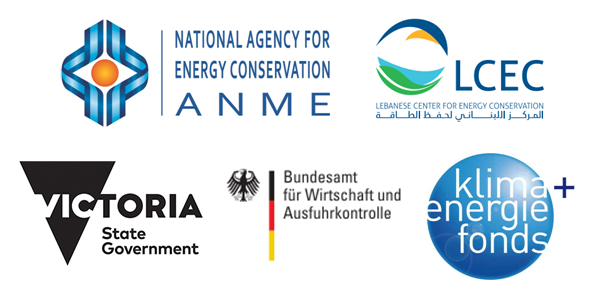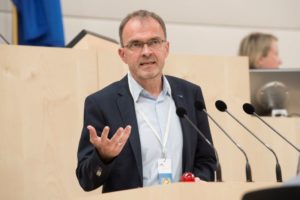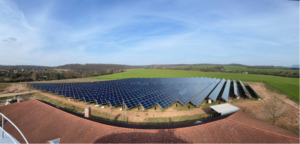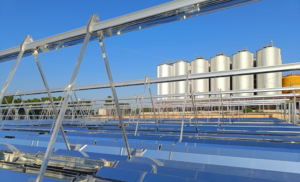

SHC Solar Award: Five Finalists with Successful Support Policies
Administrators of successful solar thermal support schemes are in the focus of this year’s Solar Award of the IEA Solar Heating and Cooling Programme (IEA SHC). The jury has chosen five finalists, of which one will receive the SHC Solar Award during the IEA SHC’s joint conference with ISES Solar World Congress (SWC 2017) in Abu Dhabi on 1 November 2017. The finalists come from Australia, Austria, Germany, Lebanon and Tunisia (see logos above). They implemented very different support policies, such as rebates and/or loans as well as building obligations. Their activities all had a strong impact on their national or regional solar heating and cooling market.
“This year, we have put the spotlight on solar heating and cooling policies to show successful case studies to policy makers and programme administrators, who have traditionally been much more focused on renewable electricity,” said Doug McClenahan, Chair of the IEA SHC Solar Award committee and Renewable Heat and Power R&D Programme Manager at Natural Resources Canada. The award ceremony will take place at the banquet dinner during the joint SHC 2017 and SWC 2017 conference. The organisers expect over 400 solar experts from all corners of the globe to catch up with the latest in research, technology trends and market development.
Nominated finalists
Among all submitted applications, the jury narrowed the list to the five finalists described below.
ANME, Tunisia: The National Agency for Energy Conservation, ANME, started an innovative residential support programme called Prosol in 2005. It combines a grant with a low-interest bank loan that is repaid via the monthly electricity bill from public electric company STEG. The budget is allocated through the national Energy Transition Fund. Prosol has helped more than 250,000 households obtain a solar water heater, with about 650,000 m2 of collector area installed in total. The USD 2.5 million initial cost of the programme has leveraged significant investment of approximately USD 211 million between 2005 and 2012 and will turn out to be profitable for the government: USD 101 million of fossil fuel subsidies are expected to be saved in 20 years (2005 – 2025), of which USD 15.2 million in savings had already been achieved from 2005 to 2010.
Conclusion: Tunisia showed successfully how a long-term, efficiently administered programme can build up a sustainable solar water heater market that also pays off in the public budget by avoiding subsidised fossil fuels.
BAFA, Germany: The Federal Office for Economic Affairs and Export Control, BAFA, started a rebate programme with a special focus on industrial solar heat in 2012. By May 2017, around 180 installations with a combined collector area of around 20,000 m2 had profited from grants of up to 50 % of the eligible net investment. This represents a strong increase compared to the approximately 20 projects funded by BAFA in the previous 10 to 15 years. The programme is unique because it not only addresses individual flagship projects, but provides support to a wide range of applications and collector sizes.
Conclusion: BAFA succeeded in creating a large number of demonstration plants in various industry sectors and established a long-term support scheme for this high-potential solar thermal application.
Climate and Energy Fund, Austria: Large-scale solar thermal applications are key to offsetting the decline in the residential solar water heater market. Recognising this trend, the Austrian Climate and Energy Fund has created a subsidy scheme for large-scale solar thermal plants for industry, district heating and cooling or commercial buildings that reach a solar share in the total heat demand of more than 20 %. Between 2010 and 2016, 161 solar thermal plants with collector areas of up to 7,020 m² were built. These projects amounted to a total of 60,061 m². A special feature of this programme is the consulting services for all applicants as well as a comprehensive system for monitoring about 50 % of the subsidised projects over one year.
Conclusion: The Climate and Energy Fund implemented a programme based on several pillars (financial and technical support, quality insurance and communication) that resulted in a significant number of MW-sized solar thermal plants for different applications.
LCEC, Lebanon: As part of the national action plan, the Lebanese Center for Energy Conservation (LCEC) set up a countrywide financing mechanism for solar water heaters in 2010. Customers are able to apply at one of the five participating Lebanese banks for an interest-free loan to be paid off over five years, plus an additional USD 200 subsidy if they choose a qualified solar thermal system. This programme has helped to more than double the solar water heater sector in Lebanon, from a total installed collector area of around 200,000 m2 in 2010 to above 530,000 m2 at the end of 2016. As a result, solar water heaters have become household commodities and public awareness of their environmental benefits has increased.
Conclusion: In Lebanon, an efficient combination of low-interest loans and subsidies increased market volume significantly and supported the purchase of quality-marked systems.
Victoria Government, Australia: Victoria’s government followed a three-step approach to support the uptake of residential solar water heaters in the state. In 2000, it started with a performance-based rebate scheme, which allocated over AUD 73 million until 2012. Since 2005, a building regulation has stipulated that homeowners of newbuilds must install either a solar water heater or a rainwater tank connected to all sanitary flushing systems. The third step was a white certificate scheme, which commenced in 2009 and makes it possible for owners of solar water heaters to generate a number of certificates depending on the deemed electricity savings. All in all, the triad expanded the market significantly. Whereas in 2001 only around 600 solar thermal system had been installed each year (about 5 % of national sales), the figure had grown to over 25,000 installations annually in 2016 (43 % of national sales), which corresponds to 56,000 m2 of collector area.
Conclusion: Victoria’s mix of measures was successful in advancing development, in driving industry growth towards better-performing products while keeping costs low.
Websites of the institutions / programmes mentioned in this article:
Australia
Austria
Germany
Programme page (in German)
Lebanon
lcecp.org.lb


